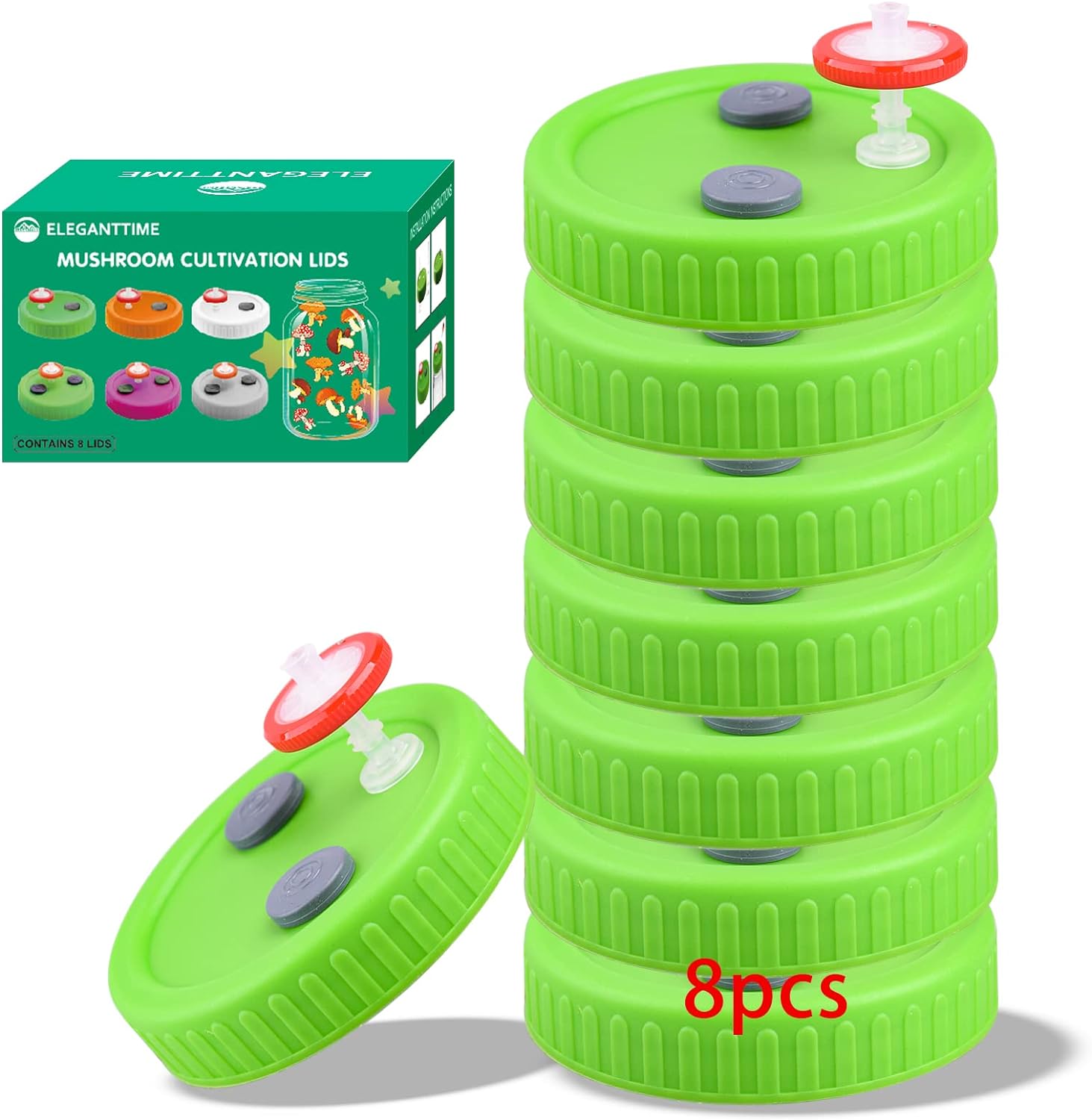Estimated reading time: 12 minutes
Introduction
In exploring mushroom liquid culture storage, it’s essential to grasp the significance of maintaining the culture under ideal conditions. The process begins with the fundamental understanding that the culture serves as a crucial element in mushroom propagation. Keeping the culture properly stored hinges on various factors, including temperature, light exposure, and selecting the appropriate container to ward off any contaminant. Additionally, preparation techniques like utilizing agar and spore syringe for inoculation lay the groundwork for a successful cultivation endeavor.
Delving further, it becomes apparent that storing the mushroom liquid culture effectively demands attention to detail and a proactive stance towards potential contamination threats. Emphasizing a clean environment, thorough sterilization, and precise sealing and labeling of containers are pivotal steps. Whether the focus is on short-term storage in a refrigerator or opting for long-term solutions such as cryopreservation, the objective remains to safeguard the culture’s condition. By adopting these measures, cultivators can mitigate risks associated with contamination, ensuring their cultures remain best to use. The process from preparing your agar to the final inoculation underscores the holistic approach required for preserving the quality and functionality of mushroom liquid culture in the cultivation process.
Key Takeaway
- Understanding Liquid Culture: Recognizing liquid culture and its role in mushroom cultivation sets the stage for proper handling and storage.
- Importance of Storage Conditions: Temperature, light exposure, and container choice are critical to prevent contamination and maintain culture integrity.
- Preparation Steps: Emphasizing cleanliness, sterilization, and proper sealing and labeling are fundamental practices to safeguard your culture.
- Storage Methodologies: Differentiating between short-term and long-term storage methods like refrigeration and cryopreservation allows for tailored approaches depending on usage plans.
- Troubleshooting and Prevention: Identifying signs of contamination and implementing preventive measures ensures the longevity and health of liquid cultures.
- Advanced Storage Techniques: Exploring advanced methods like cryopreservation and automated systems showcases how technology can enhance storage efficiency and effectiveness.
Understanding Liquid Mushroom Culture Storage Basics
The essence of storing liquid culture correctly in mushroom cultivation cannot be overstated. Liquid culture, the lifeblood of mushroom propagation, demands meticulous attention to ensure its purity and effectiveness. This section aims to shed light on the fundamental aspects of liquid culture and the pivotal conditions required for its optimal storage. By adhering to these principles, cultivators can significantly enhance the viability and longevity of their cultures, paving the way for successful mushroom cultivation endeavors.
What is Liquid Spore Culture?
Liquid culture is a vital element in the world of mushroom cultivation. It’s a specially prepared liquid nutrient medium that supports the growth of mushroom mycelium. This medium is often used to inoculate substrates to produce mushrooms. Understanding its composition and role is essential for anyone cultivating mushrooms, whether for personal interest or commercial purposes. This subsection will delve into liquid culture’s definition and key characteristics, offering a comprehensive view of its significance in mushroom propagation.
- Definition of Liquid Culture: A sterile liquid medium, often containing nutrients like glucose or malt extract, ideal for supporting the growth of mushroom mycelium.
- Key Characteristics: Includes aspects like its nutrient composition, the method of preparation, and how it aids in the rapid expansion of mycelium.
Detailed Explanation
We will explore the detailed composition of liquid culture, its preparation methods, and how it facilitates the growth of mycelium. This subsection aims to clearly understand liquid culture’s critical role in mushroom cultivation, emphasizing its importance in the cultivation process.
Liquid culture is an indispensable component in mushroom cultivation. Its proper preparation and understanding are crucial for anyone looking to venture into the fascinating world of growing mushrooms.
Essential Storage Conditions for Liquid Mushroom Spores Culture
Proper storage of liquid culture is pivotal for maintaining its efficacy and preventing contamination. This section will explore the essential conditions for storing liquid culture, ensuring its longevity and viability for future use in mushroom cultivation.
| Condition | Importance |
|---|---|
| Temperature | Ideal temperature ranges are crucial for preserving the culture’s integrity and preventing degradation. |
| Light Exposure | Proper protection from light, particularly direct sunlight, is necessary to maintain the culture’s stability. |
| Container Type | The choice of the container affects the culture’s purity. Sterile, airtight containers are recommended to minimize contamination risks. |
Case Study on Storage Conditions
A practical case study will illustrate the impact of these storage conditions on the quality and shelf life of liquid culture, highlighting best practices for cultivators.
The appropriate storage conditions for liquid culture are key to successful mushroom cultivation. By maintaining optimal temperature and light exposure and using suitable containers, cultivators can ensure the health and effectiveness of their liquid cultures, setting a strong foundation for their mushroom cultivation journey.

Step-by-Step Guide to Storing Liquid Culture
Preparing Your Liquid Culture for Storage
Proper preparation is the first crucial step in storing liquid culture effectively. Maintaining a sterile environment and ensuring the culture is sealed correctly is essential to prevent contamination. This section provides a comprehensive guide on preparing your liquid culture for storage, focusing on cleanliness, sterilization, and appropriate sealing methods.
Key Points To Take Note:
- Cleanliness and Sterilization: Ensuring all equipment and containers storing liquid culture are sterile is fundamental. This process involves flame sterilizing syringe tips and using sterilized jars or containers to minimize the risk of contamination.
- Sealing and Labeling: Properly sealing the container with an airtight lid is essential to maintain the quality of the liquid culture. Labeling the container with the date and specific strain information helps keep track of the culture’s viability and organize multiple cultures effectively.
In-Depth Preparation Techniques
As we delve deeper into each preparation step, we offer practical tips and techniques to ensure your liquid culture is stored in the best possible condition. This includes discussing the best practices for sterilizing equipment, choosing the right containers, and the importance of labeling for effective organization and tracking.
The key to successful long-term storage of liquid culture lies in meticulous preparation. Sterilization, airtight sealing, and detailed labeling are critical steps to ensure the longevity and viability of your liquid culture, setting a strong foundation for your mushroom cultivation endeavors.
Long-Term vs Short-Term Storage Methods
The decision between long-term and short-term storage methods depends on when you plan to use the liquid culture. Each method has specific considerations regarding the culture’s longevity and viability. This section compares the two, providing insights into the best practices for each storage duration.
Key Points Presentation: Table Format
| Storage Method | Duration |
|---|---|
| Refrigeration | Short-term storage, typically a few weeks to a few months. Ideal for cultures that will be used in the near future. |
| Cryopreservation | Long-term storage extends the viability for several months to a year. Suited for cultures that are not immediately needed. |
Comparison of Storage Methods
Here, we’ll explore the nuances of each storage method, discussing how they impact the growth rate, contamination risk, and the liquid culture’s overall health. This comparison will guide cultivators in choosing the most appropriate method based on their needs and timeline.
Understanding the differences between long-term and short-term storage methods is crucial for effective liquid culture preservation. Whether you choose refrigeration for immediate use or cryopreservation for extended storage, proper techniques are key to maintaining the culture’s viability for successful mushroom cultivation.
Troubleshooting Common Liquid Culture Storage Issues
Identifying and Addressing Contamination
Maintaining the purity of liquid culture is vital in the intricate process of mushroom cultivation. Contamination is a common challenge that can compromise the entire cultivation effort. Recognizing the signs of contamination and taking preventive measures are essential skills for any cultivator. This section focuses on identifying contamination in liquid culture and implementing strategies to prevent it, ensuring the longevity and health of your mushroom cultures.
Key Points :
- Signs of Contamination: Key indicators of contamination in liquid culture include changes in color, unusual smells, or visible particles that differ from normal mycelium growth. Regularly checking cultures for signs of contamination is crucial.
- Preventive Measures: To minimize the risk of contamination, maintain a sterile environment when handling liquid culture. This includes using flame-sterilized tools, working in a clean space, and practicing good hygiene.
Real-World Examples of Contamination
We will explore real-world scenarios where contamination occurred, analyze the causes, and discuss how they were addressed. These examples highlight the importance of vigilance and proper techniques in preventing contamination.
Identifying and preventing contamination in liquid culture is critical to mushroom cultivation. Cultivators can protect their cultures by understanding the signs and implementing stringent sterile techniques, ensuring their viability for successful cultivation.
Optimizing Growth Conditions in Storage
The growth conditions of liquid culture significantly impact its viability and effectiveness in mushroom cultivation. Optimizing these conditions is crucial for both short-term and long-term storage. This section delves into the key factors affecting liquid culture growth and how to maintain optimal conditions during storage.
Key Points Presentation: Table Format
| Growth Factor | Optimal Condition |
|---|---|
| Temperature | A consistent temperature, preferably in a cool place like a refrigerator, is vital for slowing metabolism and extending shelf life. |
| Light Exposure | Storing liquid culture in a dark place or using containers that block light helps maintain its stability and prevents degradation. |
| Aeration | Adequate aeration is important for some cultures. Using containers that allow for gas exchange without contamination can be beneficial. |
Case Study on Growth Optimization
Here, we’ll examine case studies where optimizing storage conditions led to notable improvements in culture viability. These studies demonstrate the direct impact of temperature, light exposure, and aeration on the health of liquid culture.
Optimizing the growth conditions for liquid culture in storage is a key factor in successful mushroom cultivation. Understanding and maintaining the right temperature, light conditions, and aeration can significantly enhance the longevity and efficacy of your liquid cultures.

Advanced Techniques for Liquid Culture Storage
Utilizing Cryopreservation for Longevity
Cryopreservation is a revolutionary technique in the quest for longevity and the effective use of liquid culture in mushroom cultivation. This method is not just about extending the shelf life; it’s about preserving the genetic integrity of the culture over extended periods. In this section, we delve into the cryopreservation process and its profound benefits for storing liquid culture, offering insights into how this technique can be a game-changer for hobbyists and commercial cultivators.
- Process of Cryopreservation: Cryopreservation involves freezing liquid culture at very low temperatures, typically using liquid nitrogen. This process slows down all biological activities, effectively putting the culture in a state of suspended animation.
- Benefits for Liquid Culture: The primary benefit of cryopreservation is the remarkable extension of the culture’s shelf life without compromising its quality. It preserves the mycelium’s vitality and genetic makeup, ensuring that when thawed, the culture remains as viable as when it was first stored.
Subsection: Insights into Cryopreservation
This subsection offers a deeper look into cryopreservation, discussing the technical aspects, the best practices for freezing and thawing, and how to maintain the viability of the culture throughout the process. We’ll explore why cryopreservation is considered one of the best methods to store liquid culture for an extended period, especially for preserving rare or important strains.
Cryopreservation is an advanced technique that offers unparalleled benefits in the storage of liquid culture. It’s a technique that ensures longevity, preserves genetic integrity, and provides a reliable way to maintain cultures for future use in mushroom cultivation endeavors.
Implementing Automated Storage Systems
In the evolving world of mushroom cultivation, implementing automated storage systems represents a significant leap in maintaining liquid cultures. These systems streamline the storage process and enhance the efficiency and reliability of maintaining cultures over time.
Key Points Presentation: Table Format
| Type of System | Efficiency Gains |
|---|---|
| Automated Refrigeration Units | Offers precise temperature control, reducing the risk of contamination and ensuring optimal growth conditions. |
| Automated Monitoring Systems | Continuously monitors the state of the culture, providing alerts for any changes that might indicate contamination or deterioration. |
| Robot-Assisted Handling Systems | Minimizes human error and contamination risk by automating the handling process of liquid culture containers. |
Implementation
This subsection examines case studies on automated storage systems implemented in mushroom cultivation facilities. We’ll look at how these systems have transformed the storage of liquid culture, offering insights into their practical benefits and how they contribute to the efficiency and success of mushroom cultivation projects.
Implementing automated storage systems is a forward-thinking approach to storing liquid culture. These systems offer significant efficiency gains, reduce contamination risks, and ensure the consistent quality of cultures, making them an invaluable asset in modern mushroom cultivation.
- Cultivation Mason Jar Lid
- 0.22um PTFE Syringe Filter
- 20mm Self Healing Injection Ports
- Mushroom(Green)
Conclusion
In concluding our guide on how to store liquid culture, the emphasis on proper storage techniques becomes undeniably crucial. Recognizing that storing mushroom liquid culture efficiently is key to the success of any mycology endeavor. The culture is essential for sustaining the growth of the mycelium, making it paramount to properly store mushroom liquid culture. Whether you’re using your liquid culture immediately or planning for future use, understanding the best way to store it ensures the vitality and purity of your mushroom strains. It’s not just about keeping the culture; it’s about preserving the potential for new mycelium cultures.
The journey from a spore print or agar plate to thriving mushroom species you are working with underscores the importance of storing your liquid culture effectively. Utilizing mason jars for liquid culture can be stored and accessed when ready to use the liquid culture, highlights a practical approach to learn how to store and use liquid culture. By adhering to these proper storage techniques, cultivators can ensure that their mushroom liquid culture is essential and maintained, paving the way for successful cultivation of the new cultures they are passionate about.

James Dunnington leads the James Dunnington Collection, featuring five unique blogs: a practical Pet Care Guide, an enlightening Ancient History Blog, a resourceful Home Improvement Guide, a cutting-edge Tech Innovation Guide, and a strategic Online Money Making platform. Each site delivers valuable insights designed to empower and inform. For updates and more tips, visit our Contact Us page to sign up for our newsletter, ensuring you never miss out on the latest content from any of these dynamic fields.

